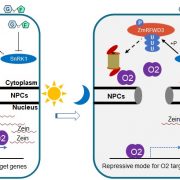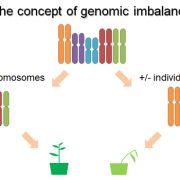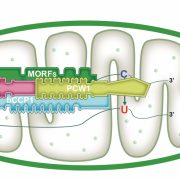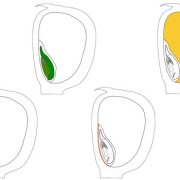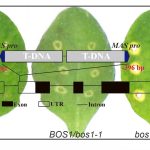Unraveling Ammonium Transporter-Mediated Nitrogen Transfer in Arbuscular Mycorrhizal Symbiosis
Jing Hui et al. identified ZmAMT3;1 as a mycorrhiza-specific ammonium transporter that transfers ammonium from fungi to plants across the plant–fungus interface and enhances nitrogen acquisition in maize. Plant Cell https://doi.org/10.1093/plcell/koac225
By Jing Hui and Lixing Yuan, China Agricultural University
Background: More than 80% of vascular plants can form symbiotic associations with arbuscular mycorrhizal fungi (AMFs). This ancient symbiosis evolved when plants conquered land, 400 million years ago, even before roots evolved. AMFs can greatly enhance the host plant’s absorbing root surface for nutrient uptake. Within colonized roots, AMFs form tree-like structures (so-called arbuscules) in cortical cells, surrounded by a specialized host membrane, the peri-arbuscular membrane (PAM). Plant transporters reside in the PAM, mediating nutrient transfer from fungi to roots. As a major nitrogen (N) form, ammonium is somehow transported across the PAM. The discovery of the transport mechanism helps to elucidate mycorrhiza-dependent N (Myc-N) uptake in plants.
Question: To identify the PAM-localized ammonium transporters (AMTs) involved in the Myc pathway, we aimed to determine how important this route was for overall plant N nutrition.
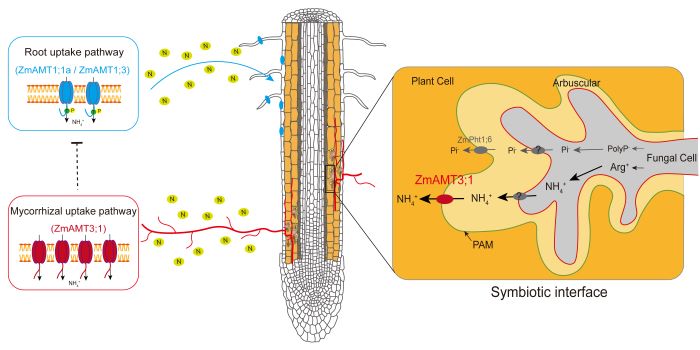 Findings: We identified a mycorrhiza-inducible ammonium transporter gene, ZmAMT3;1, in roots of maize. The encoded protein was exclusively expressed at the PAM of the cortical cells that contain arbuscules and had high-affinity transport activity for ammonium. In the lab and in field experiments using ZmAMT3;1-RNAi transgenic maize plants, we determined that substantial amounts of N were transferred from the fungus to host plants via the transporter encoded by ZmAMT3;1. We demonstrated an essential role for ZmAMT3;1 in the Myc-N uptake and highlighted the physiological significance of AMF to overall plant N nutrition. This discovery provides a new avenue for improving crop N-use efficiency involving plant–microbe interactions.
Findings: We identified a mycorrhiza-inducible ammonium transporter gene, ZmAMT3;1, in roots of maize. The encoded protein was exclusively expressed at the PAM of the cortical cells that contain arbuscules and had high-affinity transport activity for ammonium. In the lab and in field experiments using ZmAMT3;1-RNAi transgenic maize plants, we determined that substantial amounts of N were transferred from the fungus to host plants via the transporter encoded by ZmAMT3;1. We demonstrated an essential role for ZmAMT3;1 in the Myc-N uptake and highlighted the physiological significance of AMF to overall plant N nutrition. This discovery provides a new avenue for improving crop N-use efficiency involving plant–microbe interactions.
Next steps: To enhance the sustainability of agriculture, we could engineer crops with greater Myc-N uptake by exploring superior/new alleles of ZmAMT3;1 based on natural genetic variation or gene editing. We also made the fascinating discovery that AMFs may down-regulate direct root N-uptake activity carried out by other AMTs in the root epidermis. Identification of upstream regulators coordinating Myc-N and root-N uptake pathways deserves further research.
Jing Hui, Xia An, Zhibo Li, Benjamin Neuhäuser, Uwe Ludewig, Xuna Wu, Waltraud X. Schulze, Fanjun Chen, Gu Feng, Hans Lambers, Fusuo Zhang, Lixing Yuan. (2022). The Mycorrhiza-Specific Ammonium Transporter ZmAMT3;1 Mediates Mycorrhiza-dependent Nitrogen Uptake in Maize Roots. Plant Cell. https://doi.org/10.1093/plcell/koac225


